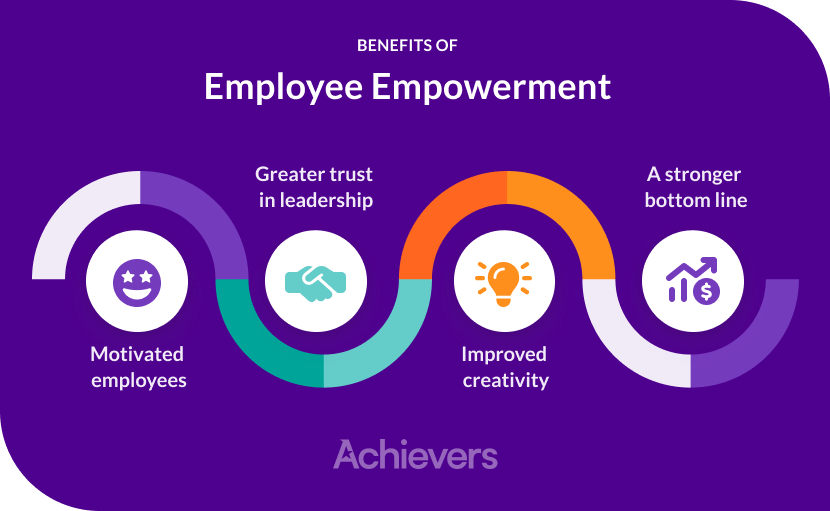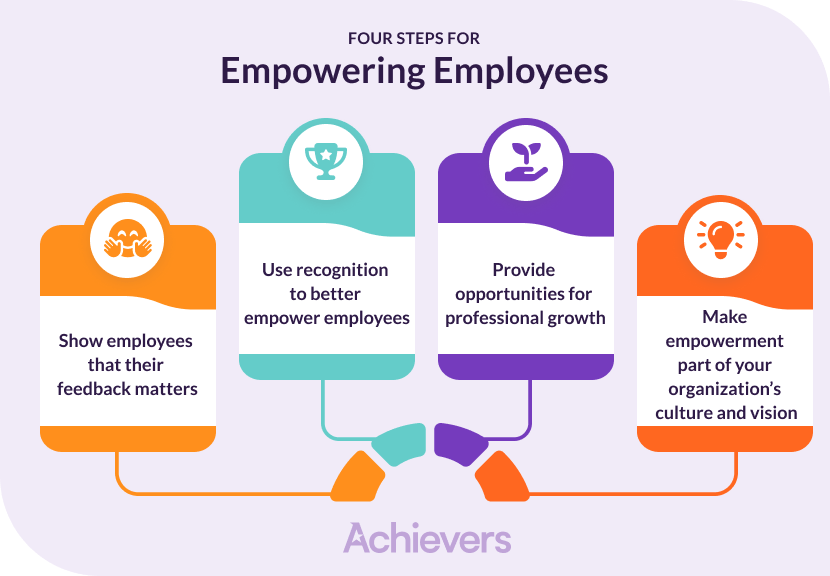Table of contents
What’s the value of employee empowerment? A study of more than 7,000 employees found that those who felt empowered ranked in the 79th percentile for engagement. Those who didn’t landed at just the 24th percentile. That gap shows how much empowerment drives engagement — and, ultimately, performance.
When employees are motivated, inspired, and confident, they’re more likely to go above and beyond in their roles. The key is to build a culture that encourages these qualities. Thankfully, with the right approach and tools, any organization can empower its employees.
Let’s break down the benefits of employee empowerment, best-practices, and how to make it a key part of your company culture.
What is employee empowerment?
Employee empowerment is a management philosophy that focuses on allowing an organization’s employees to make independent decisions and feel empowered to take action as they see fit. This contrasts with micromanagement, which does not allow for independent decision-making.
Companies that are interested in empowering employees should act on the following:
- Give employees a voice by consistently gathering and acting on their feedback.
- Offer opportunities for growth by giving more autonomy, adding responsibilities, or even providing a completely new role.
- Recognize employees regularly to boost their engagement and confidence in their abilities.
- Equip employees with the tools, training, and authority they need to succeed.
A company’s leaders, HR professionals, and fellow employees all play key roles in establishing a supportive, empowered environment. All parties need to establish mutual trust, feel comfortable taking risks, and establish clear expectations and guidelines. Without this collaboration, truly empowering employees is impossible.
What are the 5 points of employee empowerment?
The five points of employee empowerment include:
- Fostering an environment of trust and psychological safety
- Building employee confidence with recognition and incentives
- Offering flexibility in work arrangements
- Asking employees for feedback and actioning it
- Supporting professional growth with coaching and delegation

What are the benefits of employee empowerment?
When employees feel empowered, the results can transform your workplace, with benefits that include:
- Motivated employees
- Greater trust in leadership
- Improved creativity
- Stronger bottom line
Employee empowerment can instill greater trust in leadership, encourage employee motivation, lead to greater creativity, and improve employee retention — all of which ultimately result in a better bottom line.
Motivated employees
Autonomy plays a major role in empowering employees. When employees have control over how, when, and where they do their work, they tend to work harder and find their tasks more engaging. Given the opportunity to showcase their abilities, employees will give their best effort and feel more satisfied at the end of the day.
Greater trust in leadership
Leaders who empower their employees act as coaches, push their employees to do their best work, and support them along the way. Empowered employees felt that their leaders would not take advantage of their hard work. Instead, they would recognize and celebrate their wins.
Improved creativity
When employees are given autonomy, they’re empowered to think outside the box, collaborate across teams, and contribute new, innovative ideas. This increased sense of ownership also leads to higher engagement since empowered employees are more likely to take on additional responsibilities and actively support organizational goals. The ability to make decisions encourages more meaningful work, driving creativity and innovation that can have ripple effects across your organization.
A stronger bottom line
With global disengagement costs reaching $8.8 trillion, it’s clear that empowerment is key to a company’s strong bottom line. Empowered employees are more productive, more engaged, and less likely to leave — reducing turnover costs and improving performance. This drives higher revenue, stronger customer relationships, and long-term business growth.
How do you improve employee empowerment?
Improving employee empowerment starts with creating an environment where employees feel they have the tools to succeed. By connecting clear expectations with flexibility and ongoing development, managers can inspire confidence and encourage employees to take ownership of their work.
8 tips on how to empower your employees
- Delegate work responsibility based on role and skill set
- Set clear boundaries and expectations around when and how the work will be completed
- Be flexible and allow employees to adjust their workday if needed
- Ensure employees have the resources they need to be successful
- Focus on the results, not the process
- Be open to employee input to improve processes
- Support the development of soft skills
- Create a continuous and supportive learning environment
What are employee empowerment techniques?
There are several ways to make employees feel empowered at work. Be sure to incorporate the following into your best practices:
- Provide frequent feedback on their performance
- Ensure that it is honest and constructive
- Be clear and specific
- Highlight what they did well/their strengths

4 steps for empowering employees in the workplace
There are tremendous benefits to empowering employees but ingraining it in a company’s culture takes a considerable level of focus. Start implementing best practices throughout your organization by following these four steps:
1. Show employees their feedback matters
Encouraging employees to frequently provide honest feedback and actively changing your organization to fit their needs gives them a real voice in how the organization functions. According to Achievers’ Engagement and Retention Report, 90% of workers said that they are more likely to stay at a company that takes and acts on feedback.
It’s important to choose an employee feedback platform that shows leaders what drives employee empowerment through dashboards and heat maps that deliver real-time insights to guide any situation.
Companies need to tailor their empowerment strategy to individual employees and their organizational culture. Take the time to decide what employee empowerment methods work best for your team members. Facilitating open, honest conversations between employees and leaders is a great way to empower employees and build trust across your organization.
2. Recognize to empower
Frequent, meaningful recognition goes a long way in the workplace. Insights from the Achievers 2024 State of Recognition Report found that 45% of employees recognized at least monthly say they’re engaged at work, compared to 23% of workers recognized annually or less.
To empower employees through recognition, give them words of support, encouragement, and praise. Acknowledge their accomplishments so they know you’re invested in their success and trust them. Recognition from all levels ー from peers, to managers, to the C-suite ー is critical for establishing an empowering culture at your organization.
Recognizing behaviors that are in line with company values incentivizes employees to repeat them by empowering them with the confidence they need to live company values. Employees are more likely to take a specific action again if they are recognized for doing it the first time. Using a recognition platform can help build an environment of empowerment, drive individual performance, improve NPS scores, and raise stock prices.
3. Provide opportunities for professional growth
Professional growth and employee empowerment go hand in hand. When employees have opportunities to learn and grow, they’re more confident, motivated, and ready to take on new challenges.
Invest in learning and development by urging employees to share their knowledge, take on new responsibilities, and attend industry conferences or events that give them the power to learn and improve their skills. HR should also set up a clear path for career advancement at their company. Even if employees feel empowered, it can be discouraging to work towards an ill-defined or unattainable goal. Promoting employees in-house shows that growth and success have tangible rewards at your organization.
Companies also need to ensure there are plenty of coaching, mentoring, and training programs available to boost morale and offer a concrete sense of direction. And don’t neglect psychological safety, either, or employees won’t get much out of the relationship.
4. Make empowerment part of your organization’s culture and vision
Revamping your company culture to focus on empowering employees takes time and dedicated effort. All levels of your company need to feel empowered and set up for success, including HR, managers, higher-level leadership, and employees. Think of ways for existing employees to guide new employees through onboarding, set up mentoring circles or idea exchanges, and brainstorm new and exciting ways for employees to engage with other departments.
Empowering employees produces a culture of continuity that can handle any changes that come your way.
Employee empowerment starts with recognition
Empowered employees are key to better performance and business success. When employees feel recognized and valued, they engage more, collaborate better, and help drive growth.
Achievers makes it easy to boost empowerment with a recognition platform that seamlessly integrates recognition into daily work. Our tools offer real-time feedback, personalized rewards, and insights that keep employees motivated and engaged.
By focusing on employee empowerment through recognition, you can improve morale, increase engagement, and hit your business goals. With Achievers, you’ll build a culture where employees thrive — and success follows.



